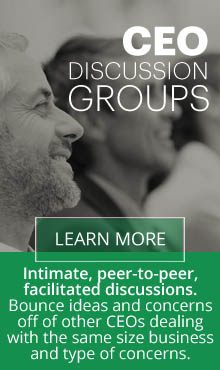 Authors Larry Bossidy and Ram Charam in their book “Execution…The discipline of Getting Things Done” included a letter to a new leader. The letter not only outlines the points of the book, but also represents what can be described as a path to organizational excellence. A leader’s responsibility is to bring the critical elements of an organization together – its people, strategies, and operations. By doing so leaders avoid falling victim to the gap between promises they’ve made and results their organization delivered.
Authors Larry Bossidy and Ram Charam in their book “Execution…The discipline of Getting Things Done” included a letter to a new leader. The letter not only outlines the points of the book, but also represents what can be described as a path to organizational excellence. A leader’s responsibility is to bring the critical elements of an organization together – its people, strategies, and operations. By doing so leaders avoid falling victim to the gap between promises they’ve made and results their organization delivered.
Dear Leader
Congratulations on your promotion! We couldn’t be happier for you. We know you are excited about, exercising your leadership at a higher level. And we’d like to share with you some information we think will help you with your new challenge.
Start by considering what skills this job requires and how they compare with the ones you have. We’re sure you’ve got the self-confidence to make this kind of candid self-assessment. If you’re short on experience in one area (most leaders are at some point in their careers, as you know), be sure you’ve got someone who’s strong in it. Overall, you’ll want to put together a team balanced with the different types of talent you need to improve your chances of success.
How well do you know your organization? Make sure you get down where the action is, talking with people at all levels, asking them questions, and listening to the answers. You’ll learn much of value about the realities of the business, and you’ll establish the personal connection that is a hallmark of a great leader.
Get a good handle early on the beliefs and behaviors of the people under your direction. Your own behaviors have a great deal to do with your success so far. You’ve insisted on boundaryless thinking, you’re open to opinions that differ from yours, and you’ve practiced and led the honest, inclusive dialogues that bring reality into the open. You have also placed a high premium on getting things done, winning, and attracting the very best and most diverse talent.
Are you among like-minded people in your new job? Does this business have an execution culture, one where people get things done because performance is recognized and rewarded? Do people embrace reality and engage in constructive debates? Or is the place full of political gamesmanship, butt-covering, and denial? If so, start creating the social software you’ll need to change the culture. It’s how you get the whole organization to follow your lead, and it’ll be crucial to maintaining your record of high achievement.
Nothing is more important to achieving results than your personal leadership of the three core processes. These are the guts of the business, and they’re your levers for changing or reinforcing the culture. The biggest single difference between businesses that execute and those that don’t is the rigor and intensity with which the leader prosecutes these processes. You will be pulled in every direction as people want you to meet community leaders, government officials, and suppliers and put you on display in every conceivable venue. But running the processes must be at the top of your priority list.
We know you believe that people are your organization’s most important assets, but your stewardship of the people process is what will convert that belief to reality. Make your people process second to none. Your success will be determined by the number of “A players you have and the extent to which you can harmonize their efforts. You need to know at least the top third of the people in your unit in terms of their performance and their growth potential. You need to be certain that appraisals are honest and direct, and that your people get the feedback, coaching, and training they need to grow. And because compensation is the ultimate driver of performance, you must ensure that your compensation system rewards the doers.
We encourage you to compare your people with those of the competition, to ask whether the performance bar is high enough, and whether people have the necessary discipline to win consistently.
Getting the strategy process right is crucial to your longer-term success and that of your organization. Are business leaders driving the process, or has it been delegated to nerdy and isolated planning types? Does the plan have the right information to allow an accurate assessment of your position versus your competition? Is it sufficiently detailed so that your people can see how they will achieve both growth and productivity improvements? You can’t settle for vague declarations in these crucial underpinnings of the plan— you need specific programs. Are the issues confronting the business identified? Does your new team have a track record of overcoming obstacles? As you know, if you don’t identify, debate and resolve the critical issues, the business stalls. Also, are resources allocated in proportion to opportunities, or does every opportunity get some resources and none get enough? Is the plan straightforward, concise, and easily understood? Remember, you want everyone in your business to have a good grasp of it.
You have a budget, but do you have the action plan the budget should represent? We see countless cases where the numbers are assembled painstakingly and presented expertly but have little to do with the reality of running the business. A one-year operating plan sets forth a template for achievement. It synchronizes all of the organization’s parts and links them with the strategy and the people processes. It nails down your team’s commitments by tying performance explicitly to incentives, so that leaders exercise all the discipline and imagination they can muster to deal with the ever-present unanticipated events.
We can’t stress enough the importance of your personal involvement in these core processes. You must be in charge from the start of each cycle, to the review, and to the follow-up steps you take to make sure the things that are supposed to happen do, in fact, happen. This is how you acquire both the knowledge and the authority to run the business as an integrated, reality-based whole. It is how you ultimately assure that all three processes are linked.
What else do you need to stay on top of? The list can get endless, but three items stand out.
- First, make sure you and your people really understand your customers: their needs, their buying behaviors, and the changes in those behaviors. Know why they would prefer your products to others. Understanding customers is the base of business success.
- Second, always look for ways to improve your results by introducing initiatives such as Six Sigma or digitization. They not only can be productive, they can also bind your people together in a common cause.
- Third, maintain and sharpen your intellectual honesty so that you’re always realistic. See things as they are, not the way you want them to be.
It will be hard at times to know how you’re doing. We hope your organization gives you the feedback and coaching you will be giving your own reports. But even when that’s the case, we have found that a leader needs a confidant, someone outside the business to help her keep her head straight. This person should be someone wise, an individual who will be candid with you and help you to keep asking yourself whether you’re growing, learning, and making the tough choices. And take care of yourself. The new job can be stressful, and you need to live a balanced life. Don’t let yourself get too low or too high. Consistent behavior is a sign of a contained ego, and inspires confidence in you from those around you.
Above all, remember that you’ve earned your leadership by your commitment to the work you’ve done. Keep that intensity of involvement and deepen it. Some people grow in their jobs, and others swell. The ones who grow are passionate about their businesses. They’re never too high and mighty to listen and learn, to be as curious and inquisitive and open to new ideas as they were the first day of their careers.

 Jeri Quinn from Driving Improved Results is an executive coach, management consultant, speaker and author who focuses on communication in her work with executives and companies. She is the author of The Customer Loyalty Playbook, 12 Game Strategies to Drive Improved Results in Your Business. With more than 40 years as a serial entrepreneur.
Jeri Quinn from Driving Improved Results is an executive coach, management consultant, speaker and author who focuses on communication in her work with executives and companies. She is the author of The Customer Loyalty Playbook, 12 Game Strategies to Drive Improved Results in Your Business. With more than 40 years as a serial entrepreneur.

